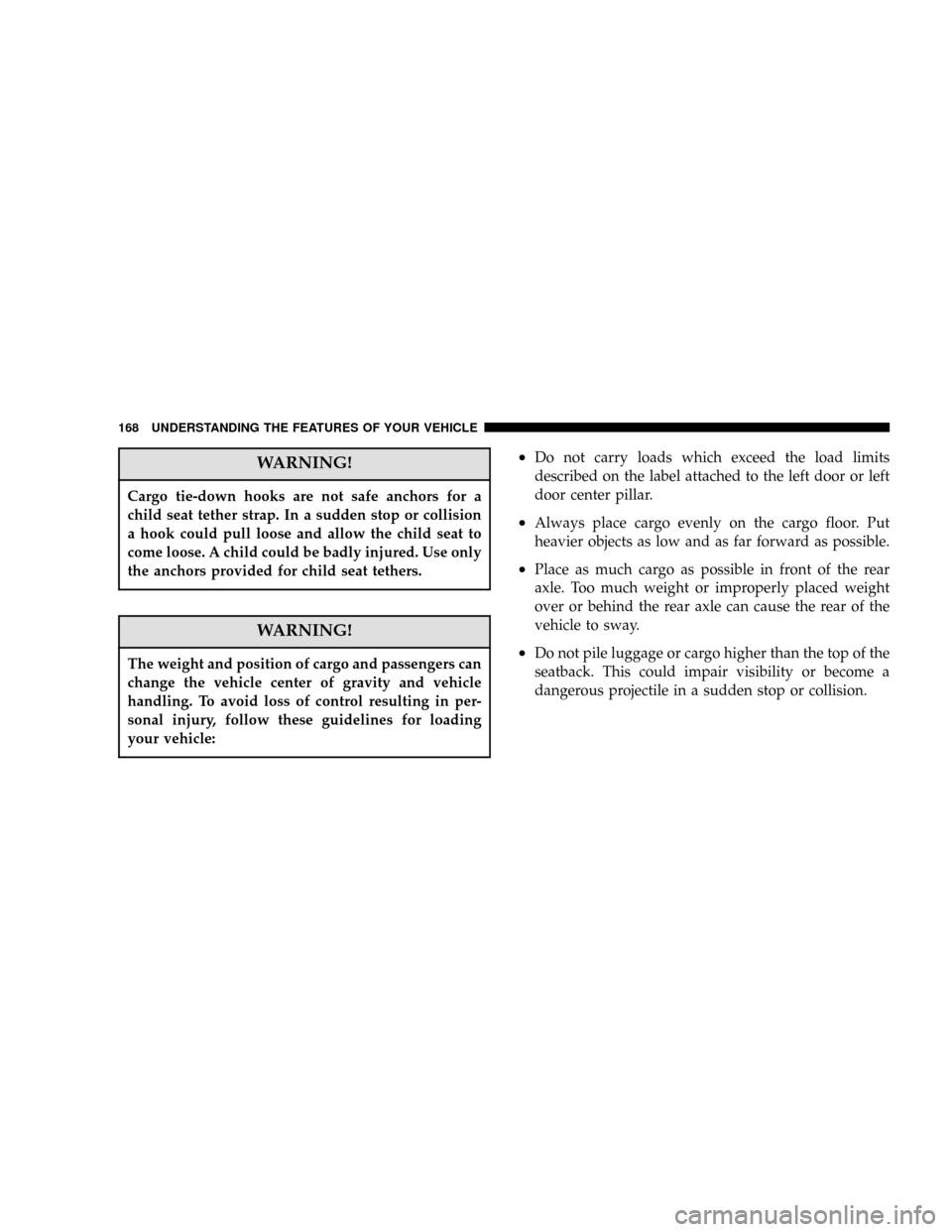Page 66 of 448

WARNING!
Improper installation of a child restraint to the
LATCH anchorages can lead to failure of an infant or
child restraint. The child could be badly injured or
killed. Follow the manufacturer’s directions exactly
when installing an infant or child restraint.
Installing Child Restraints Using the Vehicle Seat
Belt
The passenger seat belts are equipped with either cinch-
ing latch plates or automatic locking retractors, which are
designed to keep the lap portion tight around the child
restraint so that it is not necessary to use a locking clip. If
the seat belt has a cinching latch plate, pulling up on the
shoulder portion of the lap/shoulder belt will tighten the
belt. The cinching latch plate will keep the belt tight,
however, any seat belt system will loosen with time, so
check the belt occasionally and pull it tight if necessary.If the seat belt has a automatic locking retractor, it will
have a distinctive label. Pull the belt from the retractor
until there is enough to allow you to pass through the
child restraint and slide the latch plate into the buckle.
Then, pull the belt until it is all extracted from the
retractor. Allow the belt to return to the retractor, pulling
on the excess webbing to tighten the lap portion about
the child restraint. Refer to“Automatic Locking Mode”
earlier in this section.
In the rear seat, you may have trouble tightening the
lap/shoulder belt on the child restraint because the
buckle or latch plate is too close to the belt path opening
on the restraint. Disconnect the latch plate from the
buckle and twist the short buckle-end belt several times
to shorten it. Insert the latch plate into the buckle with the
release button facing out.
66 THINGS TO KNOW BEFORE STARTING YOUR VEHICLE
Page 67 of 448
If the belt still can’t be tightened, or if by pulling and
pushing on the restraint loosens the belt, you may need
to do something more. Disconnect the latch plate from
the buckle, turn the buckle around, and insert the latch
plate into the buckle again. If you still can’t make the
child restraint secure, try a different seating position.
To attach a child restraint tether strap:
Route the tether strap over the seat back and attach the
hook to the tether anchor located on the back of the seat.
For the outboard seating positions, route the tether over
the head rests, and attach the hook to the tether anchor
located on the back of the seat.
Tether Strap Mounting
THINGS TO KNOW BEFORE STARTING YOUR VEHICLE 67
2
Page 68 of 448

WARNING!
An incorrectly anchored tether strap could lead to
increased head motion and possible injury to the
child. Use only the anchor positions directly behind
the child seat to secure a child restraint top tether
strap.
Transporting Pets
Airbags deploying in the front seat could harm your pet.
An unrestrained pet will be thrown about and possibly
injured, or injure a passenger during panic braking or in
a collision. Pets should be restrained in the rear seat in
pet harnesses or pet carriers that are secured by seat belts.
ENGINE BREAK-IN RECOMMENDATIONS
A long break-in period is not required for the engine in
your new vehicle.
Drive moderately during the first 300 miles (500 km).
After the initial 60 miles (100 km), speeds up to 50 or 55
mph (80 or 90 km/h) are desirable.
While cruising, brief full-throttle acceleration, within the
limits of local traffic laws, contributes to a good break-in.
Wide open throttle acceleration in low gear can be
detrimental and should be avoided.
The engine oil installed in the engine at the factory is a
high quality energy conserving type lubricant. Oil
changes should be consistent with anticipated climate
conditions under which vehicle operations will occur.
The recommended viscosity and quality grades are
shown in Section 7 of this manual. NON-DETERGENT
OR STRAIGHT MINERAL OILS MUST NEVER BE
USED.
68 THINGS TO KNOW BEFORE STARTING YOUR VEHICLE
Page 112 of 448
NOTE: Do not fold the rear seat down with the center
seat belt buckled.
2. Fold the rear seat completely forward.
NOTE:The automatic folding rear head restraints will
lower as the seat is folded down.To Raise Rear Seat
Raise the rear seatback and lock it into place. If interfer-
ence from the cargo area prevents the seatback from fully
locking, you will have difficulty returning the seat to its
proper position. The automatic folding rear head re-
straints must be manually returned from the folded
position to the raised seating position.
WARNING!
The cargo area in the rear of the vehicle (with the
rear seatbacks in the locked-up or folded down
position) should not be used as a play area by
children when the vehicle is in motion. They could
be seriously injured in an accident. Children should
be seated and using the proper restraint system.
Folding Rear Seat
112 UNDERSTANDING THE FEATURES OF YOUR VEHICLE
Page 159 of 448
HomeLink�is a trademark owned by Johnson Controls,
Inc.
POWER SUNROOF—IF EQUIPPED
The power sunroof switch is located between the sun
visors on the overhead console.
WARNING!
•Never leave children in a vehicle, with the keys in
the ignition switch. Occupants, particularly unat-
tended children, can become entrapped by the
power sunroof while operating the power sunroof
switch. Such entrapment may result in serious
injury or death.
•In an accident, there is a greater risk of being
thrown from a vehicle with an open sunroof. You
could also be seriously injured or killed. Always
fasten your seat belt properly and make sure all
passengers are properly secured too.
•Do not allow small children to operate the sun-
roof. Never allow fingers or other body parts, or
any object to project through the sunroof opening.
Injury may result.
Power Sunroof Switch
UNDERSTANDING THE FEATURES OF YOUR VEHICLE 159
3
Page 168 of 448

WARNING!
Cargo tie-down hooks are not safe anchors for a
child seat tether strap. In a sudden stop or collision
a hook could pull loose and allow the child seat to
come loose. A child could be badly injured. Use only
the anchors provided for child seat tethers.
WARNING!
The weight and position of cargo and passengers can
change the vehicle center of gravity and vehicle
handling. To avoid loss of control resulting in per-
sonal injury, follow these guidelines for loading
your vehicle:
•Do not carry loads which exceed the load limits
described on the label attached to the left door or left
door center pillar.
•Always place cargo evenly on the cargo floor. Put
heavier objects as low and as far forward as possible.
•Place as much cargo as possible in front of the rear
axle. Too much weight or improperly placed weight
over or behind the rear axle can cause the rear of the
vehicle to sway.
•Do not pile luggage or cargo higher than the top of the
seatback. This could impair visibility or become a
dangerous projectile in a sudden stop or collision.
168 UNDERSTANDING THE FEATURES OF YOUR VEHICLE
Page 251 of 448
STARTING PROCEDURES
Before starting your vehicle, adjust your seat, adjust both
inside and outside mirrors, and fasten your seat belts.
WARNING!
Do not leave children or animals inside parked
vehicles in hot weather. Interior heat build up may
cause serious injury or death.
The gear selector must be in the N (Neutral) or P (Park)
position before you can start the engine. Apply the brakes
before shifting to any driving gear.
Normal Starting
Normal starting of either a cold or a warm engine is
obtained without pumping or depressing the accelerator
pedal. Turn the key to the START position and release
when the engine starts. If the engine fails to start within
10 seconds, turn the key to the OFF position, wait 5
seconds, then repeat the normal starting procedure.
Ignition Key Positions
STARTING AND OPERATING 251
5
Page 433 of 448

Turn Signal..................121,126,388,390
Vanity Mirror.......................... 82
Voltage............................. 187
Load Floor, Cargo....................... 169
Loading Vehicle
Tires ............................... 283
Locks................................. 16
Automatic Door........................ 19
Child Protection........................ 17
Door................................ 16
Liftgate, Tailgate........................ 16
Power Door........................... 19
Lower Anchors and Tether for CHildren
(LATCH)............................62,64
Lubrication, Body....................... 362
Luggage Rack (Roof Rack)................. 171
Lumbar Support........................ 108
Maintenance Free Battery.................. 358Maintenance Procedures................... 350
Maintenance Schedule.................... 396
Schedule“A”......................... 409
Schedule“B”......................... 399
Maintenance Schedules.................... 396
Malfunction Indicator Light (Check Engine) . . 180,348
Manual, Service......................... 420
Master Cylinder (Brakes).................. 370
Memory Feature (Memory Seat)............. 114
Memory Seat........................... 114
Memory Seats and Radio.................. 114
Mini-Trip Computer...................... 197
Mirrors................................ 78
Automatic Dimming..................... 79
Electric Powered....................... 81
Electric Remote........................ 81
Exterior Folding........................ 80
Heated.............................. 80
Outside.............................. 80
INDEX 433
10